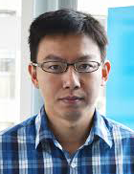2020/11/12(Thu) 15:00 -16:00 五樓第一會議室 5F, 1st Meeting Room

Title
Developing topological superconductivity in hybrid 2-dimensional systems
Speaker
柯忠廷博士 (QuTech, Delft University of Technology) Dr. Chung-Ting Ke (QuTech, Delft University of Technology)Abstract
Controlling the state of quantum matter can be realized through external parameters such as pressure, magnetic field, or electric field. Another way of modifying the ground state is to combine different materials. Hybrid material systems may result in new emergent properties. An important example being superconductor/semiconductor hybrids. These have been particularly interesting in developing topological superconductivity which is the basis for creating fault-tolerant qubits. In this talk, I will discuss two distinct superconducting hybrid systems, one base on graphene and the other on InSb quantum wells.
The first hybrid system which I will present is a superconductor/graphene/superconductor Josephson junctions (JJ). The ground state of JJs is controlled by the Andreev bound states leading to a supercurrent transport in the normal region. Depending on the properties of the normal material, a wide range of behaviors could be realized in our junctions, ranging from diffusive to short and long ballistic regimes. Furthermore, the supercurrent in these junctions can be manipulated through an external magnetic field and persist up to 2 Tesla. In such high magnetic fields, when the Landau quantization is well-developed, and we reported the first observation of supercurrent in the quantum Hall regime [1]. This result provides an important first step for developing topological superconductivity based on the superconductor/quantum Hall edges hybrid systems.
Another way to realize the topological superconductivity is to use a 2D material with strong spin-orbit coupling (SOC), such as Indium Antimonide (InSb). While coupling it to superconductors with a planar JJ geometry, a large topological phase space is predicted when a Zeeman field alters the ground state of the JJ from 0 to π. We interfaced InSb 2D electron gas with a superconductor (NbTiN) to create Josephson junctions, thus providing the first evidence of induced superconductivity in high-quality InSb quantum wells [2]. The JJs support supercurrent transport over several microns and display clear signatures of ballistic superconductivity. Furthermore, we exploit the large Lande g-factor (~25) and gate tunability of the junctions to control the current-phase relation and drive transitions between the 0 and π states. The transition is determined by a simple resonance condition, where the well-controlled Zeeman energy and Thouless energy become comparable. This control over the free energy landscape allows us to construct a phase diagram identifying the 0 and π regions, in agreement with theory. Our results establish InSb 2DEGs as a promising new material platform to study the interplay between superconductivity, SOC, and magnetism.
[1] F. Amet*, C. T. Ke* et al., Science. 352, 966 (2016).
[2] C. T. Ke et al., Nat. Commun. 10, 3764 (2019).
Language
演講語言 (Language): in English